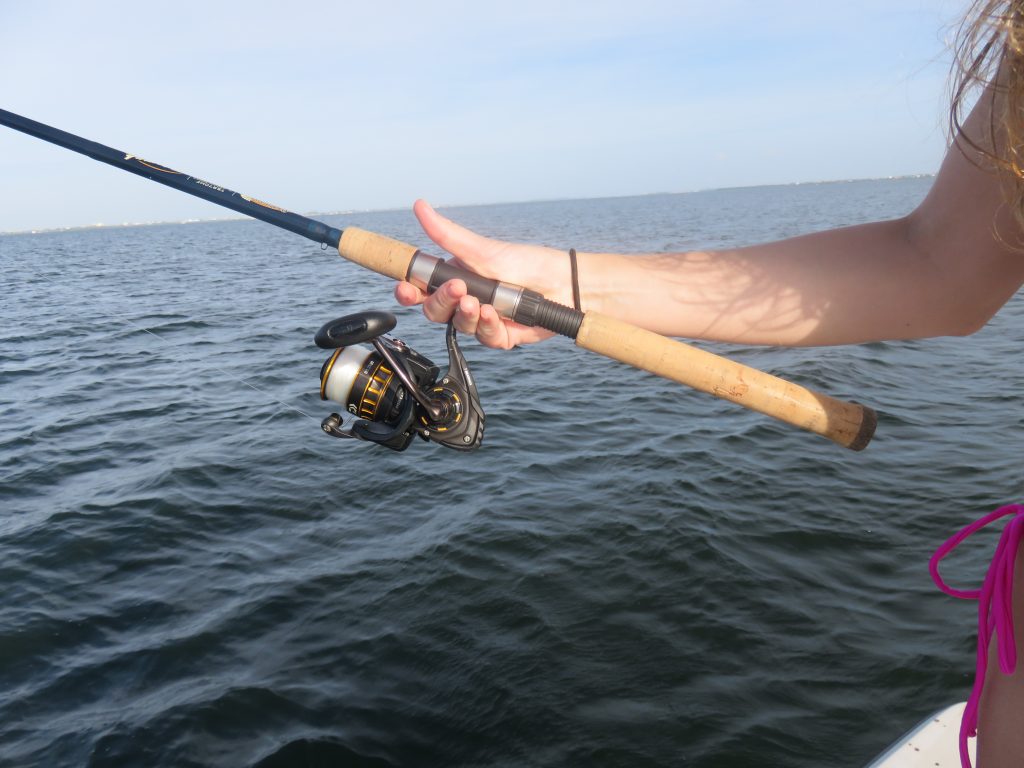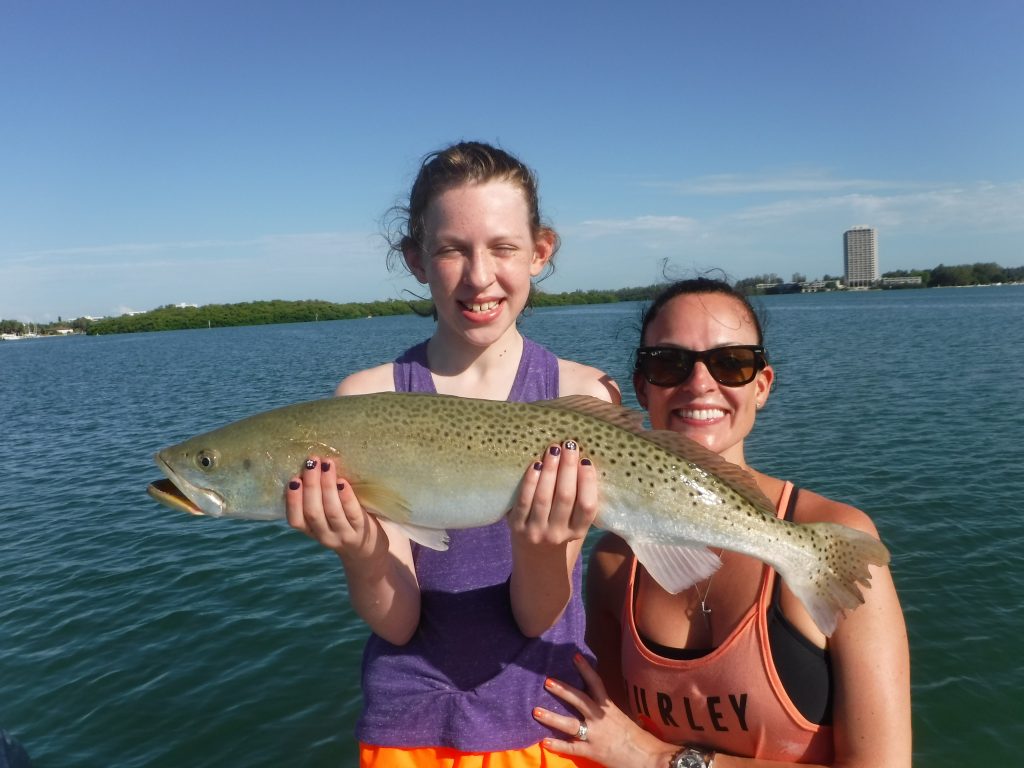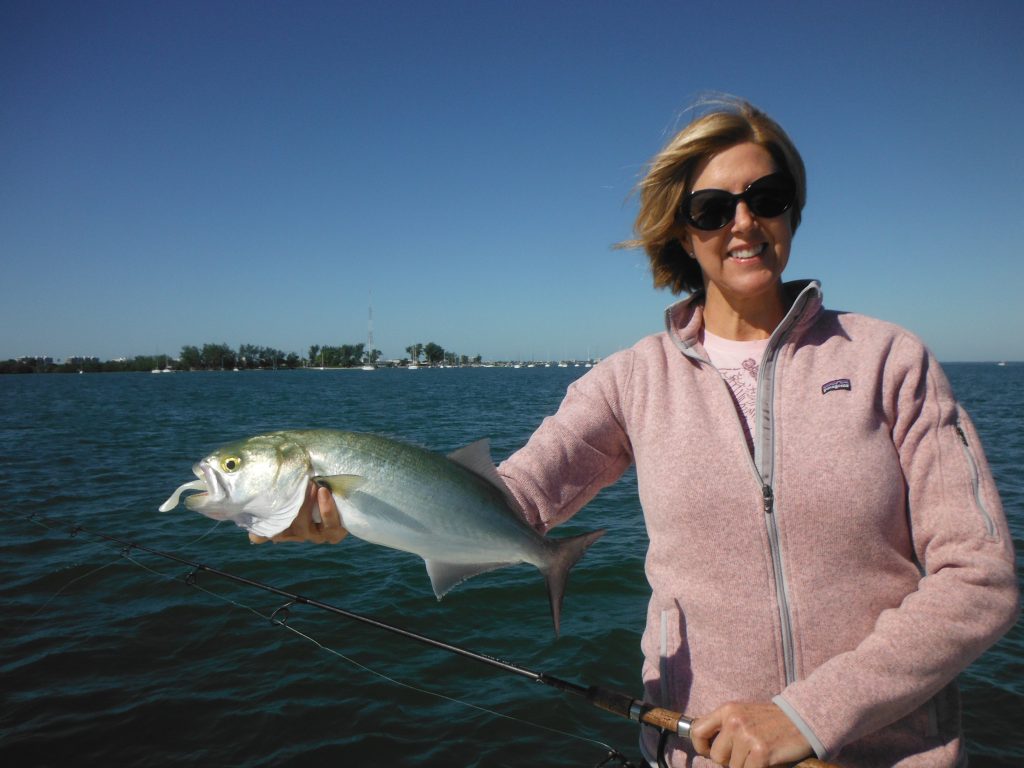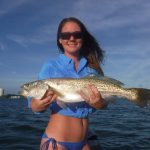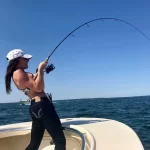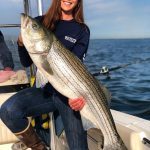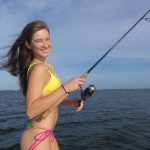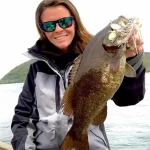Inshore Saltwater Fishing in Florida, a complete Guide
Inshore saltwater fishing in Florida, a Complete Guide is a comprehensive article that will cover all aspects of Florida saltwater fishing. Tackle, species, techniques, seasons, and locations will all be covered. Florida is known as the saltwater fishing capital of the world, and for good reason. With over 1300 miles of coastline, Florida offers anglers endless inshore fishing opportunities.
Anglers inshore saltwater fishing in Florida have many options. The shallow flats and bays, passes and inlets, and near shore Atlantic Ocean and Gulf of Mexico waters offer anglers the chance to catch many different species in diverse environments. Casting, trolling, bottom fishing, and fly fishing are all productive techniques.
Florida is flat, there is no denying it. The geography of the land extends underwater. This results in very large but shallow open waters. The shallow, clear water is the perfect environment for grass to grow. Florida anglers term these areas of submerged vegetation “grass flats”. They are the life blood for anglers inshore fishing in Florida in the shallow waters.
Fishing passes and inlets in Florida
Passes and inlets connect the inshore waters with the open Gulf of Mexico and Atlantic Ocean. These are virtual “fish highways” that game fish and bait fish use to migrate back and forth from the base to open water. Many different species can be caught in the passes and inlets year-round. Most passes and inlets also have some type of structure such as rocks, rip-rap, docks, and bridges.
The inshore waters of the Gulf of Mexico and Atlantic Ocean within a mile or two of the beaches can offer fantastic action at certain times of the year. Pelagic species such as Spanish mackerel, false albacore, cobia, tarpon, sharks, jacks, and more will migrate along the beaches close to shore within the reach of anglers and small boats.
Tackle for inshore Fishing in Florida
Capt Jim has been a fishing guide in Sarasota, Florida since 1991. Anglers who are interested in purchasing the equipment that he uses and writes about in his articles and reports can do so on the PRODUCTS page.
One great thing about fishing the inshore waters of Florida is at the same basic set up will be fine for the vast majority of species targeted. A 6 1/2 foot to 7 foot medium action spinning rod paired with a 2500-3000 series reel spooled up with 20 pound braided line or 10 pound to 12 pound monofilament line will do well in most applications. This combination is light enough to cast lures and live baits while stout enough to handle a large fish.
Anglers can shop at Amazon for a Daiwa Black Gold reel and St Croix Triumph 7′ MF rod spinning combo in this link.
“Fishing Lido Key is a participant in the Amazon Associates Program, an affiliate advertising program designed to provide a means for sites to earn advertising fees by advertising and linking to Amazon. As an Amazon Associate I earn from qualifying purchases. ”
Anglers choosing a second outfit will do well to step it up a notch or two and go with a 7 1/2 foot heavy action spinning rod with a 5000 series reel, 40 pound braid or 20 pound monofilament line. A third and final choice would be a light conventional outfit that would be great for light inshore trolling, bottom fishing, and free lining large live bait fish for larger species such as tarpon, snook, sharks, and cobia.
Once the outfit is purchased and spooled up with line, it is time to rig it. Most Florida fish species have either teeth or raspy gill covers. This requires the use of a leader. For most fishing, a fluorocarbon “shock leader” is used. This is a 24 inch to 30 inch piece of heavier fluorocarbon leader. Leader strength will depend on water clarity and the fish being targeted, with 30 pound test being a great all round choice. Toothy species such as sharks and king mackerel will require a steel leader.
Fishing the Florida flats
As previously mentioned, most inshore waters in Florida are fairly shallow. The term “flat” is a broad one. It basically is an area that is fairly large area of similar depth. Grass flats range from ankle-deep to 10 feet deep, depending on the area. Certain species will be caught either in the shallow grass or the deeper grass, and several species will be found in both environments.
Anglers seeking action and variety will do well to target fish on the deep grass flats. This refers to submerged grass beds in water between 4 feet deep and 10 feet deep. Many different species will be found over these grass beds, feeding on bait fish and crustaceans. Speckled trout, Spanish mackerel, bluefish, pompano, jacks, cobia, snapper, grouper, flounder, sea bass, and more will be found on the deep grass flats.
Drifting the deep grass flats
As these can be fairly large areas, drifting is an excellent way for anglers to locate fish and the technique is fairly simple. The boat is idled upwind and up current of the flat that is desired to be fished. The engine is then cut off in the boat is allowed to drift with the wind and tide. Anglers cast artificial lures and live bait in search of fish.
Once fish are found, anglers have a choice of whether to continue drifting or to anchor. Both approaches can be effective. Anglers who choose to anchor should have the anchor out with 20 feet of line tied off to a cleat in the stern. Once the fish are located, the anchor can be quietly lowered into the water. Anglers who choose to drift simply continue fishing until the bite slows, then motor back around and re-drift the area.
Both live bait and artificial lures work very well when drifting the deep grass flats. Live shrimp are undoubtedly the number one live bait. Live shrimp are available year-round at every bait shop in Florida. They also catch every species. Live bait fish such as pin fish, grunts, croakers, mullet, sardines, and herring can also be used.
Fishing with live bait on the flats
Live shrimp can be either free line or fished under a float. A live shrimp under a popping cork has accounted for many many trout over the years. A popping cork is a noisy float that when twitched sharply simulates the sound of a feeding fish. These are deadly on speckled trout! This rig is particularly effective and water 6 feet deep or shallower. Anglers fishing live shrimp in deeper water will often do well to free line them. This means to simply hook the shrimp and let it swim naturally with no weight.
Anglers fishing with live bait fish on the deep grass flats normally fish them under a float. Free lined bait fish such as pin fish will often dig down into the grass without the float. One deadly technique on the deep grass flats is live bait chumming. Anglers fill the live well with sardines or herring and then anchor up and use these live bait fish as chum to draw in the game fish. This technique is labor-intensive, but incredibly effective.
Fishing with artificial lures on the flats
Artificial lures are very productive, often times out fishing live bait. Lures have several advantages over bait. Anglers casting lures can cover more water then can those using live bait. Lures can also excite or aggravate fish into biting when they’re not particularly hungry.
The top artificial lure for anglers saltwater fishing in Florida is the jig and grub combo. A jig is a hook with a piece of lead molded into it near the eye. This gives the lure both casting weight and action. One quarter ounce is a very good all-around size for fishing the deep grass flats in Florida.
A grub body of some type is then attached to the jig. These bodies come in countless shapes, sizes, and colors. However, they all basically work the same, imitating either a bait fish or a crustacean. 3 inch to 4 inch grub bodies and either a shrimp tail or a shad tail are the most popular. Light colors such as white, glow, and silver work best in clear water. Darker colors such as olive, root beer, and gold work well in stained water.
Fishing with plugs
Plugs are another excellent artificial lure that are effective when fishing the deep grass flats. Plugs are plastic lures that imitate bait fish. Top water plugs float on the surface and entice fish to come up from the bottom and attack them. However, most fish on the deep grass flats are caught by subsurface plugs. The either have lips on them which causes them to dive to a desired depth or are suspending plugs which slowly sink through the water column.
Spoons are another effective artificial lure. They are basically a curved piece of metal, usually shiny, that imitate wounded bait fish. Spoons are heavy and cast a long way and have a great natural action as they wobble through the water. Silver and gold are the two most popular finishes. It is important to use a swivel when using a spoon, otherwise line twist will result.
Fishing the shallow flats
When the term “flats fishing comes up, many anglers envision sight fishing for bonefish, permit, redfish, or other species in the shallow clear Florida water. It is a bit ironic, but often times the larger fish are actually found in shallower water. Along with the above-mentioned species, snook, barracuda, sharks, cobia, jacks, and other species can be found in water less than 2 feet deep.
Fishing these very shallow waters requires a different approach. Anglers must be quiet and stealthy in order to succeed. Special shallow draft boats are often used to sneak up on the fish. Wading is another great way to catch fish on the shallow flats.
Artificial lures are often used for anglers saltwater fishing in Florida on the shallow flats. Top water lures can be very effective as they ride up over the bottom and do not get snagged. Light buck tail and soft plastic tail jigs can be used to either sight cast or blind cast as well. Weedless spoons are a very effective artificial lure, particularly for redfish.
Live bait can certainly be effective on the shallow flats as well. Anglers targeting bonefish and permit in the Keys use live shrimp and live crabs with success. These species on the shallow flats can be very spooky and difficult to catch. A live bait will increase the angler’s chances. Live shrimp and bait fish can also be used to fish potholes (small areas of slightly deeper water) in the flats.
Saltwater Fishing in Florida; bottom fishing
Bottom fishing is one of the oldest, simplest and to this day most effective fishing techniques. As the name implies, it is simply using a live or dead piece of bait fished on the bottom to entice a bite. While it is relatively uncomplicated, there are techniques and rigs that will help anglers be more successful.
The most common rig used when bottom fishing is the sliding sinker rig. Some anglers refer to this as a “Carolina rig”. It consists of an egg shaped sinker with a hole in the middle. The running line slides through the whole and then a swivel is attached. The swivel stops the sinker and allows for a leader to be attached. A 24 inch to 30 inch piece of fluorocarbon leader followed by a live bait hook finishes the rig.
Another variation of this is the “knocker rig”. With this rig the egg sinker is allowed to slide right down to the eye of the hook. This has a couple of advantages. When the sinker is on the bottom, the angler knows the bait is on the bottom as well. Also, the sinker banging against the eye of the hook will help dislodge it in case a hook get snagged. This is how the rig got its name.
Bottom fishing rigs and techniques
Another popular rig for bottom fishing is the dropper rig or “chicken rig”. This is best used when fishing vertically. The sinker sits at the bottom with a couple of hooks suspended just above the bottom, tied at intervals. This is a great rig when targeting bottom fish in open water but can be effective in all bottom fishing applications.
When bottom fishing, the goal is to use the least amount of weight possible to hold bottom. As conditions such as current flow and depth change, successful anglers will change the sinker weight along with them.
Hook size should be matched to the size of the bait being used and not the size of the fish being targeted. A #1 or #1/0 short shank live bait hook will do well in most applications. Anglers using larger live baits or cut baits will need to increase the hook size. Anglers fishing the inshore reefs in the Gulf of Mexico are required by law to use circle hooks. Many anglers you circle hooks all the time, it is just a matter of personal choice.
Fishing Florida passes and inlets
Passes and inlets are terrific spots to fish. Many different game fish species use them to migrate between the inshore waters in the open Gulf of Mexico or ocean. Most passes and inlets have abundant structure such as rock jetties, docks, fishing piers, bridges, and underwater ledges. They can also be a great option for anglers without a boat.
On the West Coast of Florida, these channels are called passes. On the East Coast of Florida they are called inlets. While they are virtually the same thing, they are a little bit different and will be covered separately. Tides are generally stronger on the Atlantic Ocean side of Florida.
Passes
Passes on the Gulf of Mexico side of Florida are often sandy and can be quite shallow. Anglers drifting the center of the passes or along the shoals and bars catch pompano, Spanish mackerel, bluefish, ladyfish, sharks, and even tarpon. Vertically jigging as the boat drifts along is a very effective technique in water over 10 feet deep. Free lining a live shrimp is also effective when the current is not too strong.
Often times, fish will be seen feeding on the surface in the passes. This is great fun and very exciting is almost any lure or bait that is well presented will get taken. Spanish mackerel, bluefish, and ladyfish are most often seen working the surface in the passes.
Most passes also have some type of structure, whether it be a jetty, seawall or some other barrier. These are prime spots to bottom fish for sheepshead, snapper, grouper, and other bottom fish. Live or frozen shrimp are the most popular bait, but live bait fish can be used as well. Snook will school up heavily in the deeper passes all along the west coast of Florida from Tampa Bay South.
Inlets
While inlets on the East Coast are similar to passes, there are a couple differences. The primary difference is the size of the inlets and the current flow. Inlets on the East Coast of Florida are generally wider, deeper, and faster, with heavier boat traffic. This makes fishing in the pass itself fairly difficult at times. Anglers must be constantly aware and put safety first.
That said, fishing the East Coast passes can be fantastic! Huge snook school up in the inlets in the summer time with many of the fish being over 20 pounds. Anglers fish with live bait fish such as grunts and mullet using fairly heavy tackle. When the current is running, it takes a lot of weight just to get the bait to the bottom. A 20 pound snook will put up a heck of a fight when aided by a for not current.
Just about every other inshore species can be caught around inlets as well. Schools of redfish will migrate through at times. Speckled trout will be found around the rocks. Flounder, snapper, grouper, sheepshead, and other bottom species will be found around the structure.
Fishing Florida bridges and docks
Bridges and docks hold a lot a fish for anglers inshore fishing in Florida. Docks provide shade, cover from the current, and forage. Docks and bridges can be productive in any depth of water. While artificial lures can be used, most anglers fishing docks and bridges use live or natural bait.
The best approach when targeting these structures is to present the bait to the up current side of the structure. Anglers in boats anchor up current a cast or so away. Then, they cast the bait towards the pilings. Anglers fishing from bridges and piers take the same approach and fish the up current side of the structure.
Night fishing for snook around the bridges is very popular in the southern half of the state. Lighted docks and bridges attract shrimp and bait fish which in turn attracts the snook and other game fish. They can often times be seen stacked up in the lights. Anglers free line a live shrimp and cast lures and flies in the shadow lines to catch them.
Florida inshore species
Tarpon
Tarpon are arguably the top inshore game fish in the world. They can be caught in shallow water from small boats. They grow VERY large, over 200 pounds. Tarpon are caught all along both coast of Florida from early spring through the fall.
Tarpon fishing in the Florida Keys is legendary. Fish are thick in the spring and are caught around bridges and on the flats. Anglers sight fish to rolling and moving schools of fish along the beaches throughout the state. Inlets and the mouths of large bays such as Tampa Bay and Charlotte Harbor will concentrate tarpon.
Tarpon are caught using live baits such as crabs, mullet, shrimp, and bait fish. Cut bait fished on the bottom works well, too. Larger versions of artificial lures that catch most Florida game fish will produce tarpon as well.
Snook
Snook are a terrific inshore game fish! They hit lures, live baits and fly, pull hard, and usually leap out of the water when hooked. Snook are found in the southern half of the state. They are very similar to largemouth bass; they are ambush predators with large mouths that inhale their prey. Snook are usually found near some type of structure. In fact, most of the most popular snook lures were originally designed to catch bass.
Snook have a distinct seasonal migration. In cooler months snook migrate up into creeks, rivers, as canals to escape the harsh conditions on the flats. As it warms up, they move out into the back waters and bays to feed. By summer, many of the fish are in the passes, inlets, and out on the beaches to spawn. By late summer, the pattern begins to reverse itself.
Redfish
Redfish are an extremely popular game fish for anglers inshore fishing in Florida. They are widely distributed and available to just about every saltwater angler in Florida and beyond.
Many anglers target reds on the shallow grass flats. They can be seem tailing and waking as they feed in water that is a foot deep. Stealth and patience are required to get close enough to cast to them. Artificial lures such as jigs, soft plastics, weedless spoons, and topwater plugs are used to fool them. Live bait, especially shrimp, can be used as well.
Reds can also be caught around structure. Docks in particular hold a lot of redfish. A large live shrimp tossed under a dock is a great way to catch them. Inlets on the east coast are top spots to catch large bull redfish. Jetties, piers, and bridges are also good spots.
Redfish can be scattered out in the spring. As late summer approaches, they school up in large numbers as they prepare to spawn. Once they school up, reds move out of the passes and inlets and into open water. Anglers finding one of these schools of mature reds in open water will have a remarkable experience.
Bonefish
Bonefish are found in the southernmost part of Florida. They are incredible game fish! Bones are among the fastest of all inshore species. They are targeted on the shallow flats in the Keys. They feed on shrimp and other crustaceans. Anglers fly fish for them as well as casting small jigs and live bait. This is challenging, but rewarding, fishing.
Permit
Permit are often targeted on the flats near Key West. They are famous for being very difficult to catch. Live crabs are the best bait. Permit are considered to be the toughest fish to catch on fly on the flats. Unlike bonefish, permit have a much wider range. They are caught in the open water along both coasts. They will school up over wrecks and artificial reefs.
Speckled trout
Speckled trout are an extremely popular inshore game fish. While not the strongest battlers in the world, they are aggressive, hit hard, are beautiful, and are great eating. Speckled trout are widely distributed and fond in all of the coastal waters of Florida. The Indian River on the east coast is famous for trophy speckled trout.
Small and medium sized trout are found in schools. Anglers drifting grass flats in 4′ to 10′ of water catch them casting jigs with a soft plastic tail, plugs, spoons, and live bait. A live shrimp under a noisy float has probably accounted for more speckled trout than all other baits combined.
Larger trout, known as “gator trout” are more solitary. They are also often times found in shallow water. They are more difficult to catch in this skinny water. Larger live baits such as mullet and grunts are top baits. Top water plugs and larger swim baits will fool them as well.
Spanish mackerel
Spanish mackerel are a terrific and often times under rated game fish. They are fast, aggressive, beautiful, and very good on the dinner plate when eaten fresh. Mackerel school up and are found in good numbers in the bays, passes and inlets, and out on the beaches.
Spanish mackerel can often be seen feeding on the surface as they terrorize helpless bait fish. This is an anglers dream as they will hit just about any bait or lure that gets near them. Spring and fall are normally the best times to find them, as they prefer water temperature from the upper 60’s to mid 70’s.
Spoons, jigs, and plugs are all productive lures for Spanish mackerel. Trolling is a very productive technique for locating them when they are not seen on the surface. Live bait such as shrimp and sardines are also effective. Mackerel will respond to chum and can be lured to an anchored boat.
Pompano
Pompano are a small, but feisty little fish. They resemble permit and mostly feed on the bottom on crustaceans. Shrimp, fiddler crabs, and sand fleas are top baits. Pompano are a favorite of surf fishermen. They are also found in bays and especially passes and inlets.
Pompano will certainly hit a jig as well. Small, compact lures bounced off the bottom produce pompano as their mouths are fairly small. Drifting with the current in passes and inlets while vertically working a jig is a proven technique.
Sheepshead
Sheepshead are a hard-fighting bottom fish. They are a member of the porgy family. Sheepshead have very distinct “human” looking teeth. They feed on barnacles, crabs, shrimp, and other crustaceans. Sheepies are almost always found near structure such as bridges, docks, oyster bars, and rip-rap. They are seldom caught using artificial lures. Sheepshead are very good to eat!
Black drum
Black drum are related to redfish but look more like sheepshead. They are a bottom feeding, structure oriented fish that feeds on crustaceans. Crabs and shrimp are the top baits. Black drum grow very large. They can be found in water that is quite shallow as well as deeper structure. Smaller fish are good to eat but larger drum can be wormy.
Mangrove snapper
Mangrove snapper are a fish species that is available both inshore and offshore in Florida. They are found throughout the state near structure. Docks, bridges, rocks, oyster bars, and mangrove shorelines will hold them. Most snapper are caught by anglers bottom fishing with live bait.
Mangrove snapper are often caught on the flats as well. They will school up on grass patches and on the edges of flats. Live shrimp, small bait fish, and cut bait will fool them. They are also aggressive at times and will take lures such as jigs and small plugs.
Grouper
Grouper are another species that many anglers consider an “offshore” species. They are found in the same structure as other bottom fish such as snapper and sheepshead. Some anglers target them but many grouper are hooked by accident. The larger fish will tear up the lighter tackle used for smaller fish.
Cobia
Cobia spend most of their lives offshore, but will wander into the inshore bays and can be caught just off the beach as well. They grow very large, over 100 pounds. Cobia can often be seen cruising just under the surface and can be sight fished. They will hit live shrimp, pin fish, and other bait fish as well as jigs and other artificial lures.
Flounder
Flounder are a very popular and plentiful species in the northern part of Florida. They are less numerous further south, the water may be a bit warm. Flounder put up a nice tussle but more importantly, they are fantastic eating! They lie on the bottom and ambush prey as it washes by in the current. Most Florida flounder caught are southern Gulf flounder.
Live bait works very well for flounder. Mud minnows and shrimp are the top baits. They will also take jigs bounced along the bottom. They will lie in likely ambush spots, near structure where possible. The tidal rivers are great flounder habitat.
False albacore
False albacore migrate along the coast of Florida in the Atlantic Ocean and Gulf of Mexico. They rarely come into the inshore bays. These fish are related to tuna fish and are very fast and powerful. The are sight cast to when breaking on the surface. False albacore move fast and can be surprisingly fussy at times. They are a terrific sport fish on spin or fly!
jack crevalle
Jack crevalle are another hard-fighting game fish targeted by anglers inshore fishing in Florida. Jacks are found all over the world in warmer climates. They school up and can very very aggressive at times. Jack crevalle grow large and will put up a tremendous battle on light tackle. They hit lutes and flies with reckless abandon. They certainly are caught using live bait as well. Jacks are great fun when they are schooled up and feeding on the surface. no food value, but a terrific game fish!
Ladyfish
Ladyfish are looked down upon by many local anglers. However, from a game fish standpoint, they are a fun fish. Ladies are aggressive, school up in large numbers, and usually jump often when hooked. Jigs are a great lure to use, they often times out fish live bait. Shrimp and bait fish will catch them as well. Ladyfish are found in the bays and passes as well as out on the beaches. They are not good to eat, but are used often as cut bait for redfish and other species.
Florida fishing by region
Florida offers anglers some great fishing all year long. However, the species and seasons are different throughout the state. Some species are only available in the southern part of the state, Others have different seasons that are productive. The regions will be broken down into sections.
Northeast Florida
Jacksonville is the center of fishing in northeast Florida. The inshore waters consist of coastal rivers with big tide differences. Redfish, speckled trout, and flounder are the top inshore species. These tidal rivers are rich with forage such as shrimp, crabs, and minnows. Oyster bars are prime spots.
Huge redfish school up at the mouth of rivers in the Jacksonville area. Fish to over 40 pounds are caught regularly. Anglers bottom fish with fresh cut bait and heavy tackle to catch these bull redfish.
Sheepshead and black drum are also popular fish targeted by northeast Florida anglers. These fish hit live shrimp and crabs and are rarely caught on lures. Structure such as bridges, docks, inlets, jetties, oyster bars, and ledges hold these fish. Reefs in the Atlantic Ocean hold these fish as well.
Spanish mackerel, bluefish, redfish, tarpon, false albacore, and jack crevalle are available of of the Jacksonville beaches. They move through in the string and early summer, then back south in the fall. The mullet run in September and October can be insane.
East Central Florida
Titusville and the Canaveral National Seashore are the center of this region. The inshore waters are dominated by Banana River, Mosquito Lagoon, and Indian River. These are really bays, very shallow and full of grass and oyster bars. Speckled trout and redfish are the top species. This area is known for having the largest speckled trout in Florida.
Reds and trout are spooky in the very shallow water. Anglers need to be quiet and stealthy in order to be successful. Live shrimp and mullet are the top live baits. Cut crabs fished on the bottom catch some very large redfish. Edges of bars and potholes in the grass flats are prime spots. Schools of redfish can be found tailing and waking on the flats.
Snook become available in decent numbers in this area. They can be caught in the back waters on the flats in the spring and fall. In winter, snook migrate up the rivers and residential canals to keep warm. In summer, snook school up heavily in all of the inlets. They are out of season, but this is the best time to catch, and release, a trophy snook. Anglers also sight cast to them on the beaches.
Action off of the east central beaches can be fantastic! Tarpon, snook, jacks, redfish, mackerel, false albacore, sharks, and more are caught close to shore off of the area beaches. Bait is the key, anglers finding the bait will likely find some action with larger game fish. Pompano and flounder are also caught off the beaches.
South Florida and the Keys
Inshore fishing in south Florida and the Keys focuses around the “big three”, tarpon, bonefish, and permit. Anglers from all over the world come here to try their hand at the premier saltwater gamefish. Anglers in shall draft skiffs quietly pole around in search of fish. This is a challenging and demanding style of fishing. However, the reward is great!
Sight fishing with fly rods was basically “invented” in the Keys by legendary anglers years ago. It remains very popular today and many consider it the ultimate angling challenge. Professional guides are plentiful in the Keys.
Other species are available as well. Snook are caught in the back waters as well as the numerous canals and in the inlets. Pompano and whiting are targeted in the surf. Snapper and grouper please anglers on bars and around structure. Mackerel and false albacore are caught just off the beaches.
Southwest Florida
The area from Boca Grande and Charlotte Harbor south to the Ten Thousand Islands offers some fantastic inshore fishing. The Ten Thousand Islands is a huge area where the Everglades dumps into the Gulf of Mexico. This area gives anglers the true remote “back country” experience.
Snook, redfish, and tarpon are the top game fish in this area. They are caught in the backwater bays and cuts all season long. Oyster bars and mangrove shorelines abound, offering perfect cover for these species. Anglers cast lures, flies, and live bait in pursuit of these fish. Modern navigation technology has made it much easier for anglers to explore this area.
More Southwest Florida species
Other species are available as well. Speckled trout, pompano, bluefish, jack crevalle, flounder, Spanish mackerel, jacks, sharks, sheepshead, grouper, snapper, drum, and even more species are caught regularly. Mangrove shorelines, oyster bars, flats, passes, bays, and reefs all hold fish.
Boca Grande is famous for giant tarpon. The run begins in April and goes into July. Anglers flock to Gasparilla Pass where tarpon congregate in huge numbers. Boats drift through the pass very close to each other and vertically fish with jigs and live bait. Anglers seeking a little elbow room can go out on the beach and sight cast to rolling fish.
West Central Florida
The west coast of Florida from Venice north to the Panhandle is a diverse area, with Tampa Bay being the most prominent estuary. It offers anglers incredible diversity and a number of species that can be caught. There are barrier islands from Tampa Bay south. North of that, the islands are gone and in the inshore Gulf of Mexico is very shallow with massive grass flats and oyster bars.
Snook,speckled trout, redfish, and tarpon are the top game fish in this area. However, mackerel, bluefish, pompano, snapper, grouper, sheepshead, flounder, drum, flounder, sea bass, whiting, cobia, sharks, false albacore, and other species are found in good numbers. Anglers visiting Sarasota can take out a Sarasota fishing charter while in the area.
Anglers cast lures such as jigs and plugs as they drift the flats and cover shore lines. Live shrimp fished under a popping cork catch a ton of fish. Chumming with live bait fish is very productive in the warmer months. Snook school up heavily in the passes and out on the beaches. Tarpon are caught off of the beaches and at the mouth of Tampa Bay in the summer.
Panhandle
The Panhandle is similar to other parts of Florida. It has back water shallow bays, barrier islands, and the inshore Gulf of Mexico. Trout, reds, sheepshead, and flounder are very popular inshore species. Shallow flats and oyster bars hold fish.
Surf fishing for pompano and other species is popular and effective. There are numerous fishing piers out in the Gulf of Mexico as well. Action on the beaches can be very good for a variety of species. Destin is known as the “Worlds luckiest fishing village” and does offer excellent inshore fishing, though it is perhaps better known for offshore fishing. Florida fishing regulations change often, view current regulations on the FWC website.

